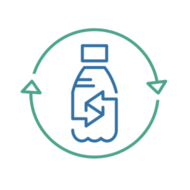What Are Bisphenols?
Bisphenols are a group of chemical compounds commonly used in the production of plastics to make them strong, durable, and clear. The most well-known bisphenol, Bisphenol A (BPA), is widely used in the manufacture of plastic resins that line food and beverage cans.
Research has uncovered adverse health effects of bisphenols, as they can leach into food and drinks from containers, leading to exposure that is linked to various health issues. However, regulations protecting consumers lag considerably behind this evidence.
Health Concerns of Bisphenols
Health concerns surrounding bisphenols, particularly Bisphenol A (BPA), stem from their ability to mimic estrogen, a hormone that plays a crucial role in the regulation of various bodily functions. This estrogenic activity has raised alarms about the potential for bisphenols to disrupt the endocrine system, leading to a spectrum of health issues.
Research has linked bisphenol exposure to a variety of concerns, including reproductive disorders, developmental problems in infants and children, increased risk of obesity and diabetes, and cardiovascular diseases. These associations have prompted extensive studies and a reevaluation of the safety levels of bisphenols in consumer products, leading to regulatory actions and the search for safer alternatives in materials that come into contact with food and beverages.
Bisphenol Regulations
The regulation of bisphenols, particularly Bisphenol A (BPA), has evolved significantly over the years in response to growing health concerns and scientific evidence. Initially used widely in food contact materials, regulatory bodies around the world have taken steps to limit or ban BPA’s use in certain products, especially those intended for infants and children.
This timeline of the history of bisphenols shows how long they have been used in consumer products before regulations were implemented.
The trend is clear. As more research is conducted (published research papers represented by the blue line), more action is taken to regulate their use. Current regulations are only partial. They do not cover all forms of bisphenols and they do not cover all product areas.
What Level of Bisphenol Exposure Is Safe?
As with most issues, a “safe” level of exposure lies somewhere on a spectrum.
Advice from The Experts & Authorities
Opinions about bisphenol and related chemicals fall on a scale that ranges from safe at moderate levels to dangerous at low levels.
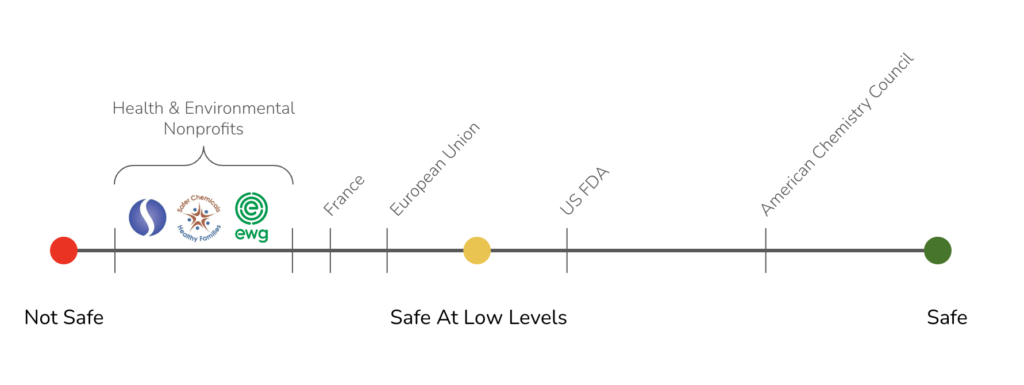
As you likely expected, health and environmental nonprofits are on the cautious side while chemical corporations are on the other, and most governments are somewhere in between.
Most websites in the US like WebMD and MayoClinic take a fairly neutral stance on the now politicized debate around BPA by deferring to the FDA.
As of 2024 the FDA website says BPA at “low-dose exposure” is safe:
Studies pursued by FDA’s National Center for Toxicological Research (NCTR) have shown no effects of BPA from low-dose exposure.
US FDA – Q&A on BPA
However, my preference is to defer to regulatory bodies outside of the US when it comes to chemical regulations.
Info on Bisphenols from Governing Bodies: EU vs US
There are three differences between information sources from the US and the EU:
- Regulation Stance – The EU takes a much more cautious stance on regulating bisphenols.
- Depth of Information – The EU provides much more information on bisphenols, related research, and what they are doing to determine the right regulatory actions.
- Frequency of Updates – The EU provides much more frequent updates.
Sensitivity By Population
Some populations are more sensitive to exposure than others. Generally, populations most sensitive to chemical exposure include:
- Infants and children: Their bodies are still developing, making them more susceptible to the harmful effects of chemicals.
- Pregnant women: Exposure can affect both the mother and the developing fetus, potentially leading to birth defects or developmental issues.
- Elderly: Aging bodies often have diminished capacity to detoxify and excrete chemicals, increasing vulnerability to harm.
- People with pre-existing health conditions: Conditions such as asthma, heart disease, or compromised immune systems can exacerbate the effects of chemical exposure.
Regulations reflect both our understanding of these varying sensitivities and a cultural bias to protect our children. Most governments who have enacted restrictions on bisphenols like BPA started by regulating it in baby bottles and then have gradually expanded to other products and use cases from there.
Which Plastic Products Contain Bisphenols?
Our most common exposure to bisphenols is from containers used to store food and beverages. Bisphenols are most commonly used to create two types of plastics: polycarbonate and epoxy.
Polycarbonate Plastics: known for their strength, durability, and clear appearance.
- Rigid Plastic Water Bottles: Often made from polycarbonate due to its clarity and durability.
- Reusable Food and Beverage Containers: Including storage containers and some types of baby bottles and sippy cups, although there has been a move towards BPA-free materials in recent years.
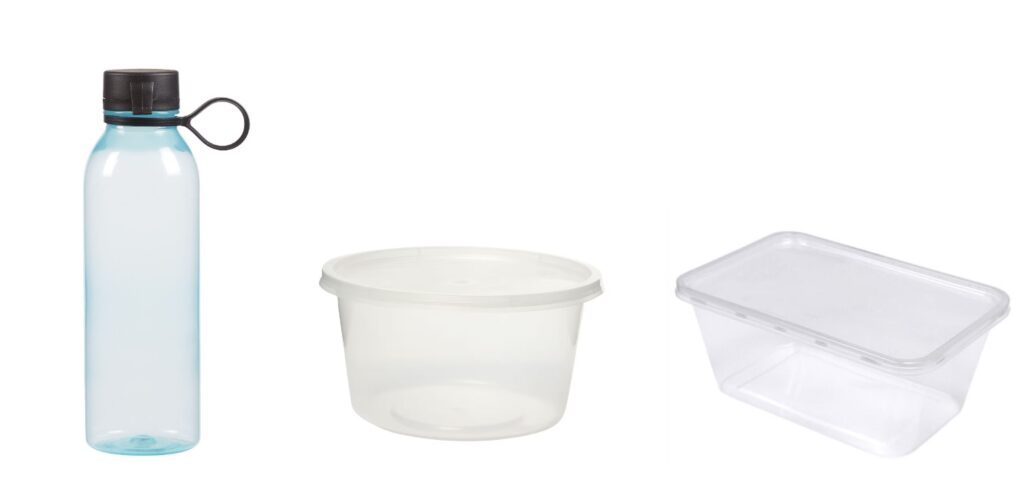
Epoxy Resins: commonly used as coatings providing a protective barrier that is resistant to heat and corrosion.
- Linings for Canned Goods: Epoxy resins are used to coat the inside of most metal food and beverage cans, acting as a barrier between the metal and the can’s contents to prevent corrosion and contamination.
- Coatings on Water Pipes: Used in the inner lining of some water pipes to prevent corrosion.
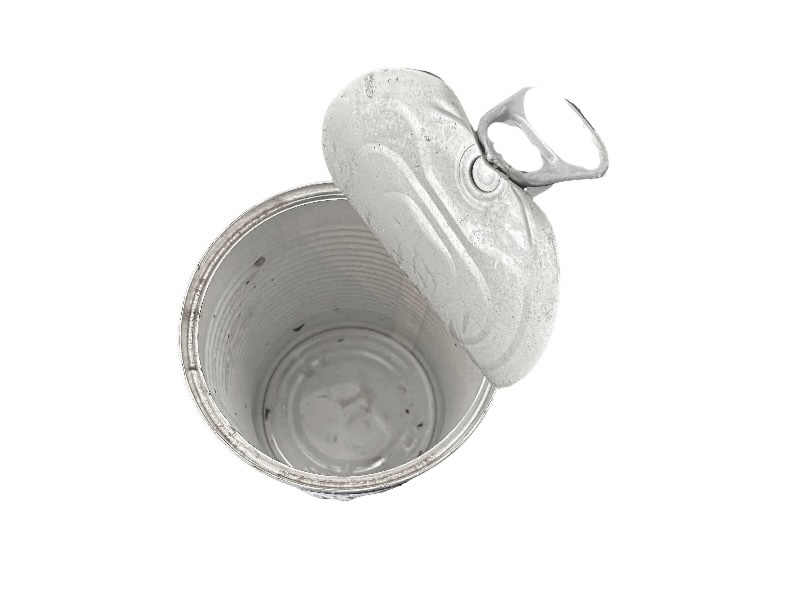
Best Way To Avoid Bisphenols
Since many products labeled “BPA Free” contain a close variant of BPA such as BPS or BPF, the best way to avoid bisphenols is to avoid using the type of plastic products that commonly contain them. This is most commonly clear plastic containers used for takeaway food, rigid reusable plastic water bottles, and the linings of cans.
When you can’t avoid this family of plastics, be careful about the way you use them. For example, heating plastics can cause their additives to leach into food or beverages. Transferring food from a plastic container into glass or ceramic before heating can reduce the chance of having bisphenols leach into your food.
Quick Tips for Reducing Bisphenol Exposure
Things To Avoid:
- Avoid plastics labeled #7
- Avoid microwaving and heating plastics or plastic cling wraps
- Avoid using plastic bottles or other containers with hot liquids
- Avoid canned foods
Things To Keep In Mind:
- “BPA Free” does not mean bisphenol free or free from other chemical additives
- Glass, ceramic, and stainless steel are safer alternatives to plastics
More on these topics covered below…
Common Questions About Bisphenols in Plastics
Plastics with BPA and BPA Substitutes
Which plastics have BPA?
Bisphenols, including the most well-known, BPA, have been used in various types of plastics since the 1950’s. BPA is mostly found in plastics with the recycling symbol number 7.
Bisphenols are most commonly found in these types of plastics:
Tough plastics common in consumer goods such as:
- reusable plastic tableware
- reusable bottles for drinks
- sports equipment
- CDs and DVDs
Clear plastics use for coatings such as:
- the insides of water pipes
- food and drink cans
Bisphenols are also commonly used in flooring, car body coatings, adhesives, thermal paper, inks, textiles, paper and more.
Which plastic bottles have BPA or other bisphenols?
The most common types of bottles that have BPA or BPA replacement bisphenols are tough and clear reusable bottles.
Here are some examples of bottle types that often have bisphenols:
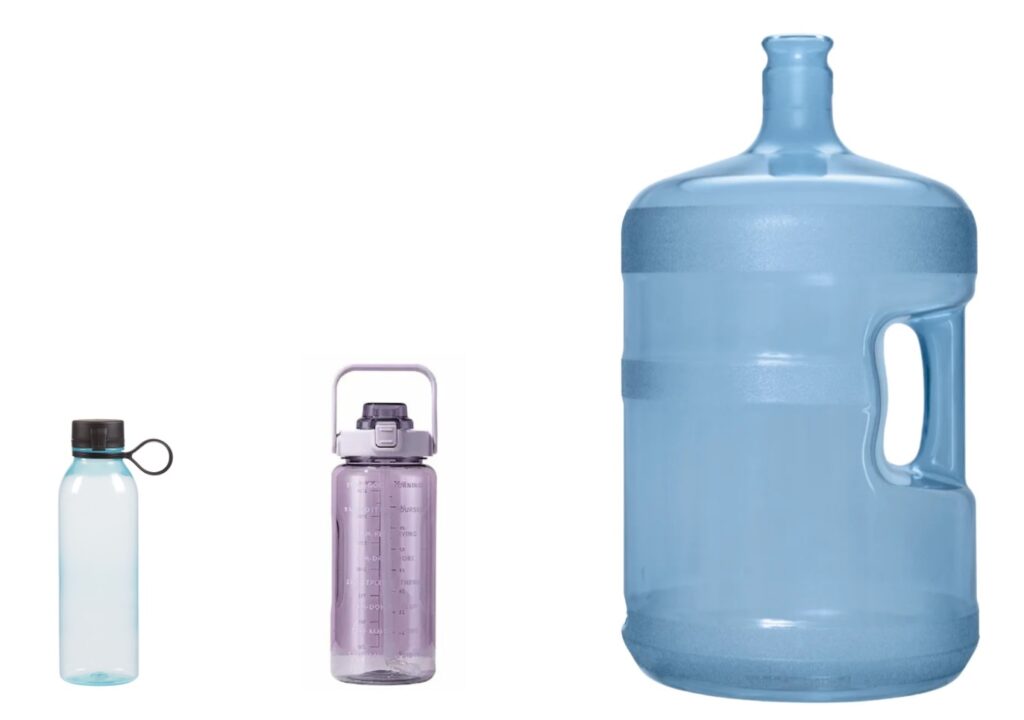
There are reusable water bottles that do not contain bisphenols, most notably those made of Tritan plastic which is most well-known in new Nalgene and Camelbak bottles.
How can you tell if plastic is BPA free?
There is no simple and easy way to tell if a plastic is BPA free. Your best bet is to avoid plastics that commonly contain bisphenols and when possible use an alternative material like glass or ceramic.
Bisphenols like BPA will not be listed on a label. Some products will display a “BPA Free” but this does not ensure they are void of bisphenols. Many products that do not use BPA use an alternative from the bisphenol family.
Is #5 plastic BPA free?
Plastic marked with the recycling symbol number 5, also known as polypropylene (PP), is generally considered to be free of bisphenols. Bisphenols are not an additive commonly used in production of polypropylene plastics.
Careful Use of Plastics with Bisphenols
Certain uses of plastics containing bisphenols can increase our chance of exposure.
How does using the microwave affect BPA plastics?
When plastic is heated, especially in a microwave, the high temperatures can initiate a process where chemicals like BPA within the plastic begin to migrate into the food or drink it contains.
This leaching process is facilitated by the breakdown of the plastic’s molecular structure under heat. Plastics are made up of long chains of polymers and various additives, including plasticizers like phthalates and bisphenols, which are added to enhance flexibility and durability. Heating causes these chains to become less stable, allowing the additives to escape from the plastic matrix.
The presence of fats, oils, or acids in the food can further accelerate this migration, as these substances can dissolve some of the chemicals, making it easier for them to move into the food.
Repeated use and the presence of scratches or cracks in the plastic can increase the surface area exposed to food, further enhancing the leaching process. This interaction between the heated plastic and the food is not just a physical transfer; it’s a chemical reaction that increases with temperature and time, meaning the longer and hotter the plastic is heated, the more significant the migration of chemicals into the food.
What is the “BPA Free” misconception?
A common misconception is that products labeled “BPA Free” are safe for use when in fact they may pose just as much of a risk as products that are not labeled BPA free.
BPA free products often contain another bisphenol such as BPS or BPF which may be just as toxic. These plastic products may also contain other chemicals that are not listed.
Concern for BPA substitutes is well documented but not nearly as well publicized as BPA itself. Learn more here: Concern About the Safety of Bisphenol A Substitutes.
How do I reduce my exposure to plastics?
I’ve systematically reduced my use of plastics by:
- Identifying the most dangerous types (including under what circumstances they are safe vs hazardous)
- Evaluating the most common plastics I use
- Finding convenient alternatives that are safer
- Adjusting my habits accordingly
Through simple adjustments that haven’t drastically changed my lifestyle I’ve reduced my exposure to plastics and my environmental plastic footprint by about 80%.
More Info: Guide To Reducing Your Plastic Exposure
Additional Resources On Bisphenols:
European Chemicals Agency (ECHA) – Page on Bisphenols – More information and resources from the agency responsible for the safety and regulation of chemicals in the European Union.
HMB4EU – List of Bisphenol Substances & Link To Substance Infocards (PDF) – This list shows how many chemicals are in the bisphenol family and links out to more information for each one. It is helpful to see that BPA is only one of many chemicals in the bisphenol family.
BPA & Fetal Development (New Jersey Department of Human Services) – This page offers a good visual guide of products that contain BPA and a list of past publications on the topic.
